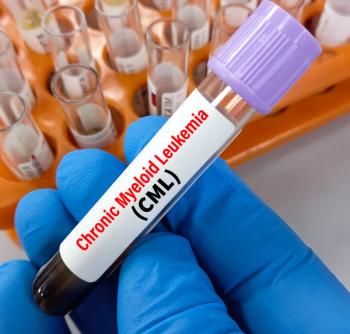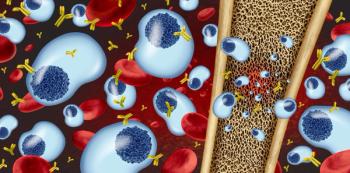
- February 2012 Infectious Disease
- Volume 78
- Issue 2
Treating Blepharitis: Annoying Condition for Patients, Vocabulary Builder for Pharmacists
When patients ask about this troublesome ophthalmic condition, pharmacists can recommend helpful management techniques.
When patients ask about this troublesome ophthalmic condition, pharmacists can recommend helpful management techniques.
Eye irritation is among the most common—and most annoying—conditions for patients. Itchy, swollen eyelids and a sensation of something in the eyes make patients miserable. For approximately 20% to 40% of Americans,1 these signs usually indicate bilateral blepharitis.
Patients with blepharitis may present with eyelash changes, watering, crusting and mattering around the lashes and canthus, photophobia, pain, and vision changes. The symptoms are usually worse in the morning, after a night of closed eyes has kept eyelids in contact with the ocular surface.2 Incidence seems to increase with age, but younger people appear to be more bothered by the symptoms than elders. This may be because they spend more time in front of computers, which provokes dry eye, or because they are more likely to wear contact lenses.3
Learning about blepharitis is bound to also expand a pharmacist’s vocabulary. Already this article has mentioned words that most pharmacists only learn as trivia (canthus [the area where the upper and lower eyelids meet] and mattering [discharge or waste]). Reading further will probably introduce several others that are Scrabble-worthy!
Blepharitis, an overarching term, is a family of inflammatory eyelid diseases. Most often blepharitis is a waxing and waning chronic condition exacerbated by seborrheic dermatitis or meibomian gland dysfunction. (Another uncommon word: The meibomian gland is a slender eyelid sebaceous gland discovered by Heinrich Meibom in the 1600s.) Approximately 15% of patients have symptoms about half the time.3 Blepharitis can also be acute; this type usually originates from allergen or irritant exposure.
Blepharitis is frequently associated with systemic diseases (Table). Patients who have anterior blepharitis, which is usually subdivided into staphylococcal and seborrheic variants, generally present with inflammation primarily around the eyelashes and follicles. Patients who have posterior blepharitis have meibomian orifice involvement and telangiectatic vascular changes of the eyelid margin. Posterior blepharitis is usually less observable to the casual bystander as a cosmetic issue, but has more pronounced physical symptoms for the patient.2
Pathophysiology
In most blepharitis cases, the eyelids are colonized with bacteria, usually Staphylococcus epidermidis, Pro­ pionibacterium acnes, Corynebacteria, or Staphylococcus aureus.4,5 Bacterial lipase changes meibomian gland secretions, increasing cholesterol concentration and creating an environment that promotes bacterial growth and proliferation. Microbes can invade tissues, or the inevitable immune system response can cause tangential damage. Bacterial toxins, mattering, and enzymes can also create inflammation. Patients’ lipid tear layer destabilizes, causing uneven spreading of tears and increased aqueous tear evaporation. It is impossible to eliminate all bacteria with antibiotics; it’s also undesirable. Bacteria play a critical role in normal eye homeostasis.2,6-9
Some clinicians believe that Demodex folliculorum—small parasitic mites that live in hair follicles, sebaceous glands, and meibomian glands—cause or contribute to chronic blepharitis. This theory is still controversial. Demodex infestation has been implicated in rosacea, which is often accompanied by blepharitis.10-12
Consequences
Although far from life-threatening, blepharitis’ impact can be significant. Patients’ visual function may decline pursuant to corneal damage and inflammation, scar formation, loss of surface smoothness, and clouded corneas. If severe inflammation develops, corneal perforation can occur. The normal progression may include eyelid damage to the lids with trichiasis, or entropion and ectropion (respectively, inward or outward turning lids that cannot close properly). Sufferers’ constant discomfort and red, swollen eyes negatively affect their well-being and their ability to carry out daily activities.
Eyelid Hygiene
Ophthalmologists and opticians encourage blepharitis sufferers to establish a systematic, long-term commitment to eyelid hygiene, because management will require lifelong vigilance. The exact process varies among clinicians.
In addition, it appears that the omega-3 and omega-6 fatty acids found in oral flaxseed oil supplements may provide some anti-inflammatory action and increase eye lubrication. 13-16
Refractory Cases
Hygienic measures rarely cure blepharitis. Treating underlying conditions, including herpes simplex, varicella-zoster, or staphylococcal skin disease, is essential; culture and sensitivity testing is recommended to determine the specific microbe involved in these diseases. Blepharitis that is related to a generalized seborrheic component often clears somewhat as the condition responds to selenium shampoos on the hair and skin, but not on the eyes. Corticosteroid therapy is reasonable if allergic dermatitis seems likely. Because dry eyes can make blepharitis intolerable, clinicians prescribe artificial tear solutions or ointments when appropriate. 2,3
In patients with a more severe, nonspecific disease, S aureus is the usual pathogen. Administering oral tetracyclines (usually doxycycline) or erythromycins for 1 or 2 months can reduce symptoms. Tetracylines perform 3 functions: reduce bacterial colonization, alter metabolism, and reduce glandular dysfunction. Increasingly, eye clinicians are using 1% azithromycin ophthalmic solution as an alternative to oral dosing. 3
Patients who develop complicating corneal infiltrates—conjunctivitis and keratitis—will need antibiotic-corticosteroid solutions. If marginal ulcers develop, clinicians may treat them empirically if they are small, but will culture larger lesions. 2
Some researchers have used the broadspectrum antiparasitic ivermectin to reduce the number of D folliculorum mites found in the lashes. This is an offlabel use. 17,18
Trichiasis, chalazion formation, corneal disease, entropion, or ectropion may require follicle destruction using electric current, laser, cryotherapy, or surgical excision.
Recently, several researchers have found that blepharitis and dry eye syndromes may improve with lid scrubs formulated with 50% tea tree (melaleuca) oil. The proposed mechanism eradicates Demodex mites.11,12,19-21 Tea tree oil has been used by Australian aborigines for centuries; it has anti-inflammatory and antibacterial effects. It is available commercially for topical use.
Keep an Eye on Technique
Pharmacists should keep certain tips in mind when helping patients who have blepharitis. First, pharmaceutical preparations like ointments and gels will stay in contact with the lid margin longer than solutions. These are usually preferred for blepharitis, but drops are preferred for corneal disease because they spread evenly.
Pharmacists need to repeat one message to patients at every visit: when applying any ointment to lid margins, using a clean application device, such as a cotton swab or a clean fingertip, is critical, as is gentle eyelid handling. Otherwise, patients may infect themselves or tear fragile skin. Although the hygienic measures described here seem simple, they do require good manual dexterity. Some patients may need help.
Patients who avoid using eye makeup until symptoms subside will be more comfortable. Additionally, they should discard and replace all eye makeup to eliminate the possibility that their cosmetics are infested with bacteria or mites.
Table 2. Eyelid Hygiene for Blepharitis
1. For 5 minutes once or twice daily, apply a wet washcloth, soaked gauze pads, or flax-filled mask, that has been warmed. This step softens gland secretions and promotes evacuation and cleansing of secretory passages.
2. Gently wash the eyelid margins while avoiding the lids or eye surface to remove adherent scurf (dead epidermal cells), collarettes (rims of thickened epidermis), and crusting. This also cleanses glandular orifices. Although many clinicians recommend washing with water, some suggest adding a few drops of baby shampoo.
3. Apply an antibiotic ointment like erythromycin or sulfacetamide, but only for short courses of treatment (chronic use is contraindicated). Generally, ointments are applied at bedtime so blurry vision is not a problem.
Adapted from references 2 and 3.
Ms. Wick is a visiting professor at the University of Connecticut School of Pharmacy and a freelance writer from Virginia.
References
1. Saccà SC, Pascotto A, Venturino GM, et al. Prevalence and treatment of Helicobacter pylori in patients with blepharitis. Invest Ophthalmol Vis Sci. 2006;47:501-508.
2. Bernardes TF, Bonfioli AA. Blepharitis. Semin Ophthalmol. 2010;25:79-83.
3. Lemp MA, Nichols KK. Blepharitis in the United States 2009: a survey-based perspective on prevalence and treatment. The Ocular Surface. 2009;7(suppl):1-24.
4. Dougherty JM, McCulley JP. Comparative bacteriology of chronic blepharitis. Br J Ophthalmol. 1984;68:524-528.
5. Groden LR, Murphy B, Rodnite J, Genvert GI. Lid flora in blepharitis. Cornea. 1991;10:50-53.
6. Dougherty JM, McCulley JP. Bacterial lipases and chronic blepharitis. Invest Ophthalmol Vis Sci. 1986;27:486-491.
7. McCulley JP, Shine WE. The lipid layer of tears: dependent on meibomian gland function. Exp Eye Res. 2004;78:361-365.
8. Bron AJ, Sci FM, Tiffany JM. The contribution of meibomian disease to dry eye. Ocul Surf. 2004;2:149-165.
9. McCulley JP, Shine WE. Meibomian secretions in chronic blepharitis. Adv Exp Med Biol. 1998;438:319-326.
10. Seal DV, McGill JI, Jacobs P, Liakos GM, Goulding NJ. Microbial and immunological investigations of chronic nonulcerative blepharitis and meibomianitis. Br J Ophthalmol. 1985;69:604-611.
11. Kheirkhah A, Casas V, Raju VK, Tseng SC. Corneal manifestations of ocular demodex infestation. Am J Ophthalmol. 2007;143:743-749.
12. Liu J, Sheha H, Tseng SC. Pathogenic role of Demodex mites in blepharitis. Curr Opin Allergy Clin Immunol. 2010;10:505-510.
13. Wojtowicz JC, Butovich I, Uchiyama E, et al. Pilot, prospective, randomized, double-masked, placebo-controlled clinical trial of an omega-3 supplement for dry eye. Cornea. 2011;30:308-314.
14. Pinheiro MN Jr, dos Santos PM, dos Santos RC, Barros Jde N, Passos LF, Cardoso Neto J. Oral flaxseed oil (Linum usitatissimum) in the treatment for dry-eye Sjögren’s syndrome patients [in Portuguese]. Arq Bras Oftalmol. 2007;70:649-655.
15. Larmo PS, Järvinen RL, Setälä NL, et al. Oral sea buckthorn oil attenuates tear film osmolarity and symptoms in individuals with dry eye. J Nutr. 2010;140:1462-1468.
16. Macsai MS. The role of omega-3 dietary supplementation in blepharitis and meibomian gland dysfunction (an AOS thesis). Trans Am Ophthalmol Soc. 2008;106:336-356.
17. Filho PA, Hazarbassanov RM, Grisolia AB, Pazos HB, Kaiserman I, Gomes JÁ. The efficacy of oral ivermectin for the treatment of chronic blepharitis in patients tested positive for Demodex spp. Br J Ophthalmol. 2011;95:893-895.
18. Holzchuh FG, Hida RY, Moscovici BK, et al. Clinical treatment of ocular Demodex folliculorum by systemic ivermectin. Am J Ophthalmol. 2011;151:1030-1034.
19. Gao YY, Di Pascuale MA, Elizondo A, Tseng SC. Clinical treatment of ocular demodecosis by lid scrub with tea tree oil. Cornea. 2007;26:136-143.
20. Gao YY, Di Pascuale MA, Li W, et al. In vitro and in vivo killing of ocular Demodex by tea tree oil. Br J Ophthalmol. 2005;89:1468-1473.
21. Gao YY, Xu DL, Huang LJ, Wang R, Tseng SC. Treatment of ocular itching associated with ocular demodicosis by 5% tea tree oil ointment [published online ahead of print September 27, 2011]. Cornea.
Articles in this issue
over 13 years ago
New Drugs of 2011, Part 2over 13 years ago
Personalized Medicine Brings Pharmacy Science Back to the Futureover 13 years ago
Health Care Reform...Disruptive Changes?over 13 years ago
A Decade of "Smart" Infusion Pumpsover 13 years ago
Overactive Bladder Management: Challenges and Opportunitiesover 13 years ago
Infectious Diseases Watchover 13 years ago
Diabetes Watchover 13 years ago
Cold Watchover 13 years ago
Tech Product Newsover 13 years ago
Technology NewsNewsletter
Stay informed on drug updates, treatment guidelines, and pharmacy practice trends—subscribe to Pharmacy Times for weekly clinical insights.























































































































































































































